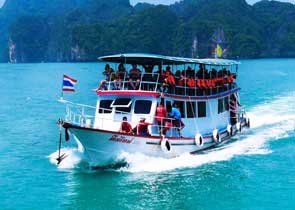Kedarnath is a sacred Hindu temple located in the Uttarakhand state of India. It is one of the Char Dham Yatras, which are a set of four pilgrimage sites that are considered highly significant for Hindus. The other three Char Dham Yatra destinations are Badrinath, Gangotri, and Yamunotri. The main attraction of Kedarnath Dham is the Kedarnath Temple, which is an ancient stone temple dedicated to Lord Shiva. The temple is constructed in a traditional North Indian architectural style and is believed to have been established by the Hindu philosopher and saint Adi Shankaracharya in the 8th century.
Kedarnath Dham is not only a place of religious significance but also a destination for nature enthusiasts and trekkers due to its stunning natural beauty and serene atmosphere. It holds a special place in the hearts of millions of Hindus and continues to draw pilgrims from all over India and beyond.
Kedarnath Yatra Tour Packages | Discover-Uttarakhand
Here's some information about the Kedarnath Dham Yatra
Location: Kedarnath is situated in the Garhwal region of the Himalayas, at an altitude of about 3,583 meters (11,755 feet) above sea level. It's nestled in the Rudra Himalaya range and is surrounded by stunning natural beauty.
Pilgrimage Significance: Kedarnath is dedicated to Lord Shiva and is one of the 12 Jyotirlingas, which are considered the holiest abodes of Lord Shiva. The temple is said to have been built by the Pandavas, the legendary heroes of the Indian epic, Mahabharata.
Yatra Route: The Kedarnath Dham Yatra is a challenging and spiritually rewarding journey. Pilgrims typically start their journey from Rishikesh or Haridwar and make their way to Gaurikund, which is the base camp for the Kedarnath trek. From Gaurikund, it's about a 16-kilometer (10-mile) trek to reach Kedarnath temple. You can choose to walk or hire a mule or palanquin for the journey.
Kedarnath Temple: The temple itself is a small stone structure with a conical top and is surrounded by snow-capped peaks. It is open only for about six months a year, from late April to early November, due to extreme weather conditions.
Accommodation: There are accommodations available in Gaurikund, as well as a few guesthouses and dharamshalas (pilgrim rest houses) along the trek route and in Kedarnath. However, facilities are basic, and it's advisable to make reservations in advance during the yatra season.
Best Time to Visit: The best time to undertake the Kedarnath Dham Yatra is during the summer months, from May to June and then again from September to October, when the weather is relatively pleasant and the temple is open for pilgrims.
Religious Significance
Kedarnath is considered one of the holiest shrines in Hinduism, and it is believed that Lord Shiva resides here in the form of a natural rock lingam (symbol of Shiva). Devotees come here to seek the blessings of Lord Shiva and to perform rituals and prayers for the well-being of their families and themselves.
Sightseeing
While the primary purpose of the Kedarnath Yatra is to seek blessings at the temple, the surrounding region also offers breathtaking natural beauty and opportunities for sightseeing. Here are some of the popular sightseeing spots and activities you can explore during your Kedarnath Yatra:
Sightseeing Spots
Kedarnath Temple: The main attraction of the yatra is the Kedarnath Temple itself. It's a stone-built temple located at an elevation of around 3,583 meters (11,755 feet) above sea level. The temple is a marvel of ancient architecture and spirituality.
Bhairavnath Temple: This temple is dedicated to Lord Bhairav, an incarnation of Lord Shiva. It's located near the Kedarnath Temple and is an important stop for pilgrims.
Gandhi Sarovar: Also known as Chorabari Tal, this glacial lake is a serene spot for nature lovers. It's located around 3 kilometers from Kedarnath and is surrounded by stunning mountain views.
Vasuki Tal: This high-altitude lake is situated at an altitude of 4,150 meters and offers a challenging trek. The views from Vasuki Tal are breathtaking, and it's a great place for camping.
Triyuginarayan Temple: This ancient temple is believed to be the place where Lord Shiva and Goddess Parvati got married. It's a sacred spot and is located around 20 kilometers from Kedarnath.
To reach Kedarnath Dham, you can follow these general steps:
Reach the nearest town or city: The nearest major town to Kedarnath is Rudraprayag, which is well-connected by road to various cities in India. You can reach Rudraprayag by road from cities like Delhi, Haridwar, Rishikesh, and Dehradun.
Travel to Gaurikund: Gaurikund is the starting point for the trek to Kedarnath Temple. It is located approximately 16 kilometers away from Kedarnath. You can reach Gaurikund by road from Rudraprayag or by hiring a taxi or using public transportation. Keep in mind that the road from Rudraprayag to Gaurikund may be narrow and winding.
Trek to Kedarnath Temple: From Gaurikund, you'll need to trek to Kedarnath Temple. The trekking distance is approximately 16 kilometers, and it usually takes 6-8 hours to complete the journey on foot. The path is well-marked, but it can be steep and challenging, so be prepared for a strenuous trek. You can also hire a mule or a palki (a type of chair carried by porters) if you prefer not to walk.
Helicopter Services (Optional): If you have limited time or physical limitations, you can also consider taking a helicopter ride from Phata, Sersi, or other nearby helipads to Kedarnath. Helicopter services are available, but they can be expensive and subject to weather conditions.
Accommodation in Kedarnath: There are several accommodation options available in Kedarnath, ranging from budget guesthouses to more comfortable lodges. It's advisable to book your accommodation in advance, especially during the peak pilgrimage season.
Visit Kedarnath Temple: Once you reach Kedarnath, you can visit the Kedarnath Temple, which is dedicated to Lord Shiva. The temple opens for a few months each year, usually from April or May to November, depending on weather conditions.
Return Journey
After your visit to Kedarnath Temple, you can retrace your steps and trek back to Gaurikund. From there, you can continue your journey to other destinations or return to Rudraprayag.
Please note that weather conditions in the Himalayan region can be unpredictable, so it's essential to check the latest weather updates and road conditions before planning your trip. Additionally, the opening and closing dates of the temple may vary from year to year, so it's advisable to confirm the schedule in advance.
Inclusions:
- Accommodation in hotels/resorts as per package
- All applicable meals (breakfast, lunch, dinner)
- Transportation as per itinerary
- All transfers and sightseeing
- Driver charges, toll tax, parking charges
- Assistance in Darshan at Kedarnath Temple
Exclusions:
- Helicopter tickets (if opted for helicopter to Kedarnath)
- Pony/Palki charges for Kedarnath trek
- Any airfare
- Personal expenses such as laundry, telephone calls, tips & gratuity, mineral water, soft & hard drinks, porterage
- Anything not mentioned in the inclusions
- Additional sightseeing or extra usage of the vehicle, other than mentioned in the itinerary
- Entrance Fees & Guide charges
- Any cost arising due to natural calamities like, landslides, road blockage, political disturbances(strikes), etc
- Still camera/video camera charger
- 5% GST & all Government Taxes
Related Packages


